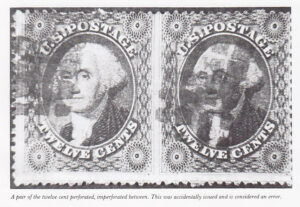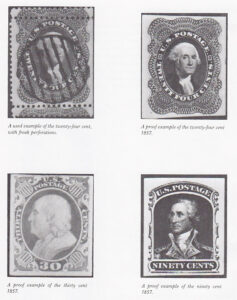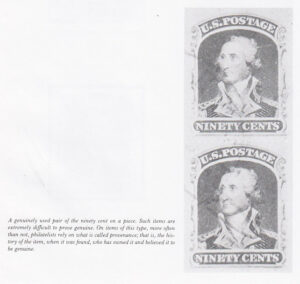The Five- and Ten-Cent Stamps of 1857
The five cent 1857 is a very tricky stamp because its proper determination rests on both color and type factors. The types are relatively easy to distinguish, and they, too, were caused by the exigencies of the perforating machinery. In 1860, an engraver went back over the plate and cut off the tiny projectiles at the top and bottom of the stamp, creating the second type; Type I still had the projectiles. The colors or shades of this stamp make it exceedingly difficult to distinguish the proper catalogue umber, even for rather adept philatelists. The shades of Type I are brick red (#27), red brown (#28), Indian red (#28A), and brown (#29). The colors of the Type II are orange brown (#30) and brown (#30A). for the four colors of Type I, many philatelists have questioned the Scott catalogue listing of such minor distinctions—and they are indeed small differences. However, the Type II stamp creates no difficulties in identification as the orange brown and brown shades are very distinctive.
The ten cent 1857 is much like its earlier perforated counterpart, with the addition of a Type V, which is a cutaway plate leaving more room for the perforating machine. The ten cent 1857 comes in a multitude of shades, but unlike the five cent these are treated by collectors as the same stamps; only specialists attempt to find an example of each shade variety for their collection.
The twelve-cent (#36) stamp is just a perforated version of the earlier 1851 twelve cent. In late 1859, a new plate was prepared, which can be distinguished from the original plate by its light frameline instead of the usual heavy frameline around the stamp. A minor variety, Scott designates this #36b, and it sells for marginally more than the plate #1, #36.
The Twenty-Four-Cent, Thirty-Cent, and Ninety-Cent 1857 Stamps
All of the high denomination stamps of the 1857 issue are very rare. Only 750,000 of the 24-cent values were printed, although it is known that some were returned to the Post Office Department as unsold and then were destroyed. Experts estimate that perhaps 10,000 to 12,000 examples exist in collectors’ hands. This estimate is one that meets with informal verification by those who peruse auction catalogues and dealers’ stocks. Of the 30-cent value 337,000 were printed; again, some were returned unsold to the department. A fair evaluation of this stamp would be that between 8,000 and 10,000 survive. Of the 90-cent value 29,000 were issued, and some of these were returned to be destroyed. Because of the short period during which the 90-cent value was available before its demonetization, a somewhat higher percentage was saved, and eDepartment as unsold and then were destroyed. Experts estimate that perhaps 10,000 to 12,000 examples exist in collectors’ hands. This estimate is one that meets with informal verification by those who peruse auction catalogues and dealers’ stocks. Of the 30-cent value 337,000 were printed; again, some were returned unsold to the department. A fair evaluation of this stamp would be that between 8,000 and 10,000 survive. Of the 90-cent value 29,000 were issued, and some of these were returned to be destroyed. Because of the short period during which the 90-cent value was available before its demonetization, a somewhat higher percentage was saved, and experience indicates that there are perhaps 3,000 to 4,000 examples still in philatelic hands. After the Civil War, a number of the high values of the 1857 sets were retrieved from southern post offices and sold to stamp dealers.
It is worth remembering that over 24,000 copies of the five-dollar 1893 Columbus stamp were printed, out of which, because of its commemorative nature, its earl popularity, and high face value, certainly 12,000 or more still survive. And yet a five-dollar Columbian in reasonably nice condition, four times as common as the #39, sells for much much more. Popularity, you say. No doubt true, but popularity is influenced by availability. If a collector cannot find a stamp offered, as is often the case with the ninety cent 1857, he is apt to replace it with something else on his want list.



